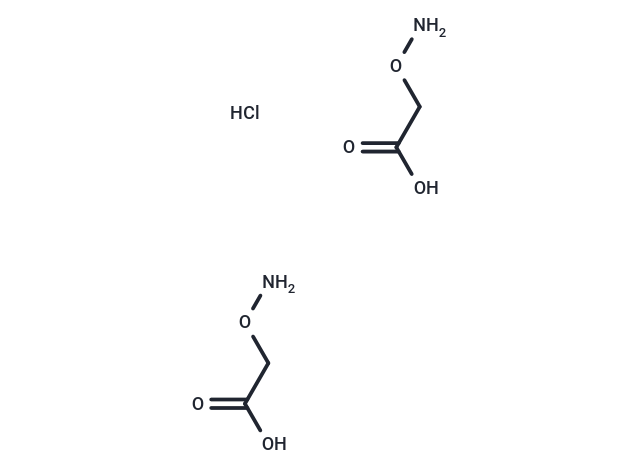Shopping Cart
- Remove All
 Your shopping cart is currently empty
Your shopping cart is currently empty

Aminooxyacetic acid hemihydrochloride (Carboxymethoxylamine Hemihydrochloride) is a malate-aspartate shuttle (MAS) inhibitor which also inhibits the GABA degradating enzyme GABA-T.

| Pack Size | Price | Availability | Quantity |
|---|---|---|---|
| 500 mg | $41 | In Stock | |
| 1 g | $68 | In Stock | |
| 1 mL x 10 mM (in DMSO) | $45 | In Stock |
| Description | Aminooxyacetic acid hemihydrochloride (Carboxymethoxylamine Hemihydrochloride) is a malate-aspartate shuttle (MAS) inhibitor which also inhibits the GABA degradating enzyme GABA-T. |
| In vivo | At various intervals after aminooxyacetic acid(AOAA) the rats were either injected with one of the convulsive drugs or sacrificed for analysis of the GABA concentration.?AOAA caused a rapid initial (0-30 min) and a later slower increase of GABA in cerebellum and whole brain.?In the synaptosomal fraction the GABA accumulation was delayed and less pronounced when compared to the whole brain.?The bicuculline induced convulsions were markedly potentiated during the first hour but completely blocked from 2-6 h after AOAA.?Picrotoxin showed a somewhat different pattern to bicuculline in the interactions with AOAA.?The initial strong potentiation was not observed but the later phase of protection was present.?In the interactions with 3-MPA, the effect of AOAA was always protective.?The time to onset of convulsions was gradually increased during the first 30 min after AOAA.?This protective effect remained practically unchanged up to 6 h after AOAA.?However, once started, the convulsions were generally of the same duration and intensity.?The results can be interpreted as GABA accumulating after AOAA stimulates GABA receptors to a degree more or less proportional to the whole brain GABA concentration and further that GABA synthetized in neurons is liberated, stimulates inhibitory bicuculline sensitive (predominant) and excitatory bicuculline insensitive receptors and is captured to a large extent by non-neuronal cells[1]. |
| Alias | Carboxymethoxylamine Hemihydrochloride |
| Molecular Weight | 109.3 |
| Formula | C2H5NO3·0.5HCl |
| Cas No. | 2921-14-4 |
| Smiles | Cl.NOCC(O)=O.NOCC(O)=O |
| Relative Density. | 1.7848 g/cm3 (Estimated) |
| Storage | Powder: -20°C for 3 years | In solvent: -80°C for 1 year | Shipping with blue ice. | |||||||||||||||||||||||||||||||||||
| Solubility Information | DMSO: 45 mg/mL (411.71 mM), Sonication is recommended. | |||||||||||||||||||||||||||||||||||
Solution Preparation Table | ||||||||||||||||||||||||||||||||||||
DMSO
| ||||||||||||||||||||||||||||||||||||

Copyright © 2015-2025 TargetMol Chemicals Inc. All Rights Reserved.